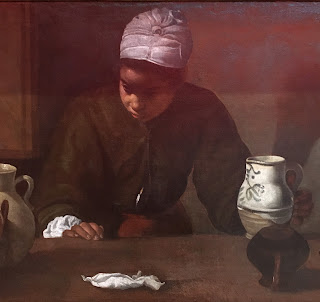In the summer, we spent ten days in Ireland, starting and ending with Dublin, where I went to the National Gallery of Ireland. I knew they had the extraordinary painting by Caravaggio, called The Taking of Christ. I saw it once at the National Gallery in London years ago and, along with his painting of the crown of thorns being forced onto Christ's head, which is in the Kunsthistorisches Museum in Vienna, it is my favourite of the paintings I've seen by Caravaggio.
I told myself not to take any pictures, because it is pointless, but in the end I did take some, trying to somehow capture and take away something of the way the picture portrays Christ and Judas Iscariot at the moment of betrayal:
What I love most about this picture is its perspective. Its subject is the supper at Emmaus, but you only realise that after looking at it closely. Thus, you find yourself in the same position as the young maid who is the central figure - suddenly aware that something is present that you weren't aware of at first glance .
Here she is, in the midst of kitchen work, suddenly sensing something strange and startling nearby:












Wonderful! I didn't even know about that Velazquez. Thanks, Zoe.
ReplyDeleteAlthough they date it years earlier than the London picture, it surely must be meant as a pair to the Martha Velasquez at Britain's National Gallery
ReplyDeleteAbsolutely. And the dates seem to be quite close...
ReplyDelete